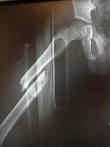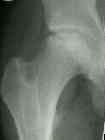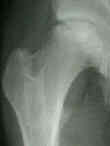- Discussion:
- see pediatric femur frx
- commonest site of fracture of the femoral shaft is in its middle third, where normal anterolateral
bowing of diaphysis is  at its maximum;
at its maximum;
- torsional force produced by indirect violence results in a long spiral or oblique frx, whereas a
transverse frx is caused by direct trauma;
- green stick frx are more common in the distal third;
- birth frx from OB trauma, usually occur in mid 1/3 & are transverse;
- excessive bleeding ( > 500 ml) or more is not uncommon;
- source of bleeding is usually the profundus femoris artery which course around femoral shaft, the
vessels of richly vascular muscles enveloping the femur, or the vessels in bone itself;
- diff dx:
- child abuse;
- bone tumor
- be suspcious of femoral shaft fractures occuring from low energy trauma such as a football pile up;
- poor quality films may mask a NOF, UBC, or even osteosarcoma;
- Operative Considerations:
- children who have uncontrolled muscle spasticity, such as those w/ head injuries or severe cerebral palsy, do not tolerate external
immobilization well;
- IM Nailing: rigid nails:
- IM nailing using rigid nails may be indicated in children as young as 12-13 years;
- concern is that IM nailing in immature patients may cause AVN
- position:
- consider placing the patient in the lateral position which will allow the hip to be flexed so that the guide wire can be placed
posterior to the medius tendon;
- ref: Patient positioning on the operative table for more accurate reduction during elastic stable intramedullary nailing of the femur: a technical note.
- entry hole for rigid nails:
- after the age of 7 most of growth to greater trochanter is appositional and not physeal (it has been observed that trochanteric
growth arrest after age 7 will not correct congenital coxa vara);
- consider placement of the guide pin thru the medial 1/3 of the greater trochanter;
- standard IM nail placement into the piriformis fossa may disrupt the posterior branch of the MFCA (blood supply to hip);
- also note that insertion of the nail anterior to the piriformis fossa, may place the patient at risk for femoral shaft fracture;
- note: make sure that small diameter nails (9 mm) are available;
- Townsend DR and Hoffinger S (2000) authors describe results of a technique in which the nail is placed through the tip
of the greater trochanter (avoiding the piriformis fossa and possible damage to medial circumflex artery);
- between 1988 and 1995, the authors performed this procedure on 34 patients, who ranged in age from 10 - 17 years;
- there were no infections, nonunions, rotational deformities, or implant failures.
- 20 patients with open physes had a followup of 2 years or more.
- no patient had avascular necrosis of the femoral head develop.
- the authors recommend the trochanteric tip entry point for IM nailing in children;
- references:
- Intramedullary nailing of femoral shaft fractures in children via the trochanter tip
- Antegrade intramedullary nailing of pediatric femoral fractures using an interlocking pediatric femoral nail and a lateral trochanteric entry point.
- Proximal Femoral Radiographic Changes After Lateral Transtrochanteric Intramedullary Nail Placement in Children
- Intramedullary nailing of femoral fractures in children through the lateral aspect of the greater trochanter using a modified rigid humeral intramedullary nail: preliminary results of a new technique in 15 children.
- Closed, locked intramedullary nailing of pediatric femoral shaft fractures through the tip of the greater trochanter.
- Premature greater trochanteric epiphysiodesis secondary to intramedullary femoral rodding
- Interlocking intramedullary nailing of femoral-shaft fractures in adolescents: preliminary results and complications
- Fixation of Length-Stable Femoral Shaft Fractures in Heavier Children: Flexible Nails vs Rigid Locked Nails
- A systematic review of rigid, locked, intramedullary nail insertion sites and avascular necrosis of the femoral head in the skeletally immature.
- Locked intramedullary nailing in the treatment of femoral shaft fractures in children younger than 12 years of age: indications and preliminary report of outcomes.
- Twenty-Year Experience with Rigid Intramedullary Nailing of Femoral Shaft Fractures in Skeletally Immature Patients
- The management of pediatric subtrochanteric femur fractures with a statically locked intramedullary nail.
- Debate: a healthy 12-year-old boy with an isolated mid-diaphyseal femur fracture should be treated with an antegrade, locked, intramedullary rod.
- flexible nails: (see synthes technique manual)
- may be indicated in children between 5-12 years of age for difficult fractures or for obese patients;
- in children older that 12 years of age flexible or rigid nails may be used depending on the circumstances;
- flexible pins are placed from the distal femoral metaphysis in a retrograde manner
- typically one pin is inserted medially and one is inserted laterally;
- in the study by Bar-on, et al. (1997), flexible IM nails were compared to external fixation in a prospective study;
- consisted of a prospective study w/ 19 patients w/ age ranges from 5-13 years;
- in their study, time to full wt bearing, ROM, and return to school were all faster in the flexibile nail group;
- nails were inserted from the proximal end for more proximal fractures and from the distal end for more distal fractures;
- there were no cases of limb length inequality nor malunion in the nail group;
- malrotation:
- (70%) subtrochanteric femur frx and 5/7 (71%) supracondylar femur frxs healed with anterior angulation of about 5°
- ref: Elastic nailing for pediatric subtrochanteric and supracondylar femur fractures.
- controversies:
- higher incidence of complications (bending of nails) in children heavier than 100 lbs;
- time for nail removal spans between 6-12 months, when circumferential callus appears to be solid and the fracture line is
no longer visible;
- with early removal, there is a concern of a higher rate of malunion; (Gulati, letter to the editor) (Wall replies)
- references:
- External fixation or flexible intramedullary nailing for femoral shaft fractures in children. A prospective, randomised study.
- The operative stabilization of pediatric diaphyseal femur fractures with flexible intramedullary nails: a prospective analysis.
- Titanium elastic nails for pediatric femur fractures: a multicenter study of early results with analysis of complications
- Ender rod fixation of femoral shaft fractures in children
- Elastic stable intramedullary nailing of femoral shaft fractures in children
- Comparison of Titanium Elastic Nails with Traction and a Spica Cast to Treat Femoral Fractures in Children
- Limb Geometry After Elastic Stable Nailing for Pediatric Femoral Fractures
- Decreased Complications of Pediatric Femur Fractures With a Change in Management
- Antegrade versus retrograde titanium elastic nail fixation of pediatric distal-third femoral-shaft fractures: a mechanical study.
- Femur Fracture in Preschool Children: Experience with Flexible Intramedullary Nailing in 72 children
- Assessing leg length discrepancy following elastic stable IM nailing for paediatric femoral diaphyseal fractures
- Flexible intramedullary nailing in paediatric femoral shaft fractures
- Fixation of Length-Stable Femoral Shaft Fractures in Heavier Children: Flexible Nails vs Rigid Locked Nails
- Use and abuse of flexible intramedullary nailing in children and adolescents.
- references for prebending:
- Does the extent of prebending affect the stability of femoral shaft fractures stabilized by titanium elastic nails?
- references: complications:
- Complications of Pediatric Femur Fractures Treated With Titanium Elastic Nails: A Comparison of Fracture Types
- Complications of Elastic Stable Intramedullary Nail Fixation of Pediatric Femoral Fractures, and How to Avoid Them
- Complications of titanium elastic nails for pediatric femoral shaft fractures
- Complications of Titanium and Stainless Steel Elastic Nail Fixation of Pediatric Femoral Fractures
- Letter: Complications of Titanium and Stainless Steel Elastic Nail Fixation of Pediatric Femoral Fractures
- Letter re: Complications of Titanium and Stainless Steel Elastic Nail Fixation of Pediatric Femoral Fractures
- Acute complications associated with removal of flexible intramedullary femoral rods placed for pediatric femoral shaft fractures.
- Pediatric Femoral Shaft Fractures Treated With Titanium Elastic Nailing
- Elastic Nailing for Pediatric Subtrochanteric and Supracondylar Femur Fractures
- ender rod fixation:
- in the report by Cramer KE, et al., Ender rod fixation for pediatric femoral shaft fractures evaluated in a prospective study;
- 57 frx in 52 patients were evaluated;
- patients were younger than 14 years, and had fractures in the middle 3/5, and canal size greater than 7 mm;
- there were no delayed unions and all fractures healed within 12 weeks
- ref: Ender rod fixation of femoral shaft fractures in children
- Complications:
- potential complications:
- include avascular necrosis (as long as proximal physis is open) & risk of injury to trochanteric growth center
- 13-year-old male sustained femoral shaft frx which was treated w/ IM nail;
- one year later the patient developed AVN; (the nail was subsequently removed)
Ligamentous instability of the knee in children sustaining fractures of the femur: A prospective study with knee examination under anesthesia
Intramedullary nailing of femoral fractures in adolescents
Intramedullary nailing versus submuscular plating in adolescent femoral fracture



